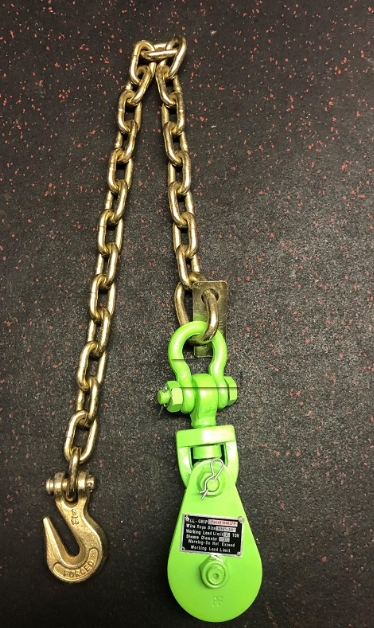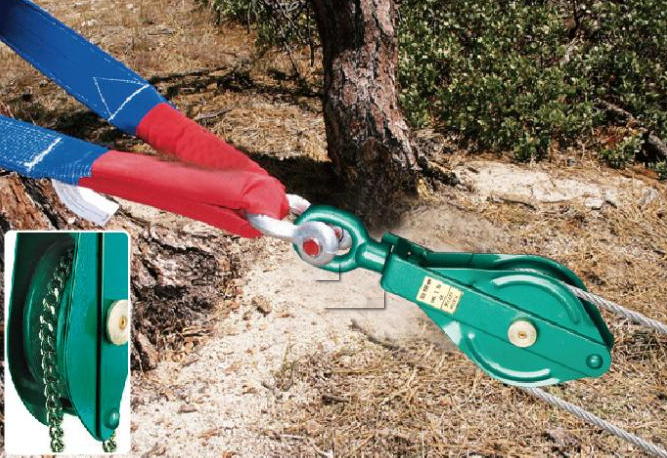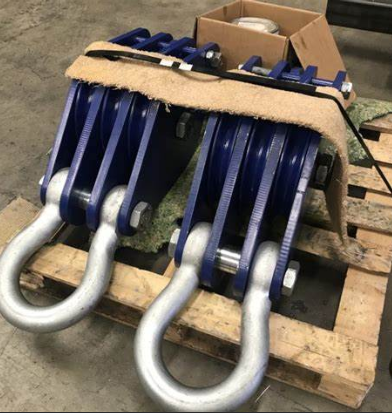1410, PARKSON, 44-60 ZHONGSHAN ROAD, QINGDAO, CHINA
A snatch block is a specific kind of pulley, a simple device that makes it easier to lift or pull a heavy load with less force. It’s sort of a strengthening mechanism. All pulleys use a spool and casing to hold a rope.
A snatch block, in particular, has a side plate, which is sometimes called a cheek plate, that opens so you can easily put your cable or wire rope into it. You’ll typically use it to tow vehicles or lift cargo overhead.
In addition to loading wire rope, these tools may have additional connection points for different types of jobs.
Snatch blocks, like many aspects of towing, must comply with federal and state regulations.
For example, the State of Washington mandates that these devices “must have permanently affixed durable factory identification, stating the working load limit,” and that all towing equipment must be periodically checked and re-certified.

What types of snatch blocks are there?
Snatch blocks have different end-fittings, like hooks, chain-and-grab-hook assemblies, or closed shackles.
Pulleys also come in different sizes and can be made of different materials. They also have different mechanisms that open their encasement and a range of working load limits.
To figure out which snatch block is right for your job, understand whether your job involves overhead lifting, towing horizontally, or towing a vehicle in a ditch. This changes how strong your snatch block needs to be to handle the degree of force required.
You also want to make sure your encased pulley can safely anchor to the fitting you need to anchor it to. Furthermore, your snatch block must the correct size to accommodate your cable or wire rope.
What are the benefits of using a snatch block for overhead lifting or vehicle recovery?
snatch block
The increased leverage you get with a snatch block lets your wire rope or cable last longer, and you can get a wider range of jobs done without having to invest in extremely heavy-duty equipment (that is, maximum strength winch winders or crane motors).
Two ways to use a snatch block
There are three primary ways you’re likely to use a snatch block: for an overhead lifting job using a crane, to tow a car on a highway, or to recover a vehicle that’s been wrecked in a ditch or in the woods.
In this article, we’re going to walk through two of these three ways to use a snatch block effectively: how to use a snatch block as a vehicle recovery tool in different contexts.

How to easily tow a car on a highway?
The most typical kind of vehicle recovery you’ll experience will probably be straightforward: a car is stuck or stalled out on the highway, or in a flat driveway.
You can definitely recovery a car or truck in this situation with a snatch block.
You’ll also need:
wire rope
a winch winder
a shackle
a hook end-fitting
Before you take any of these steps, make sure that oncoming traffic can easily see and maneuver around your tow truck and the vehicle you’re recovering.

You’ll want to set up safety cones and orange lights, and it’s important to make sure the vehicle has its hazard lights on if at all possible.
Once you’ve set that up, take the following steps.
1.Open the snatch block
2.Insert the wire rope from the towing winch
3.Once it’s secured, close the cheek.
4.Connect the heavy-duty shackle to the snatch block
5.Secure the shackle to and anchor point on the underside of the vehicle you want to tow.
6.Pull the wire rope back through the snatch block and connect the end-fitting of the wire rope to the towing vehicle.
7.There should be two parallel lines of wire rope running from the tow truck to the stuck vehicle. Put weights on these taut wire ropes for safety.
8.Engage the clutch.
9.Pull the stuck vehicle using the winch winder and tow truck.

Towing a stuck vehicle on the highway is only one scenario where you’ll benefit from this neat tool. The steps to successfully recover a car stuck in a ditch or in the woods are a bit different.
How to recover a vehicle from a ditch or in the woods?
forest road
Other tools you may need:
a recovery sling
wire rope
a winch winder
a chain-and-grab-hook end-fitting,
recovery sling
To use a snatch block with an attached chain and grab hook to maximize your towing strength, do this:
Park on a flat, stable surface where the tow truck will not be interrupted.
Attach the chain and grab hook to a strong, sturdy, stable anchor point. This must be something other than the tow truck or the wrecked vehicle. A nearby tree or a third vehicle can work.
Either loop the chain around the anchor point and connect the chain to itself with the hook or connect the hook of the chain to the anchor point directly.
Disengage the clutch on the tow truck. Pull the wire rope from the winch and thread it through the case opening. If the wire rope is too thick, you can swap out the snatch block’s case with one that accommodates a thicker spool.
Attach the end of the wire rope to a grab hook or RTJ hook end-fitting. Then, connect that end-fitting to the undercarriage of the vehicle you want to tow.
If there are no connection points due to the wreckage, loop a recovery sling or tow strap around part of the frame of the wrecked car to create a point of connection.
Turn your tow truck’s engine on and begin winching. The electric winch pulls its wire rope cable through the snatch block, to successfully tow a wreck out from where it’s stuck
Snatch blocks are a great asset for any towing job. Now that you know how to use them, why not explore further and see which other auto-hauling tools can help you succeed?
